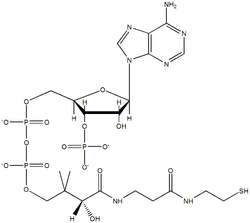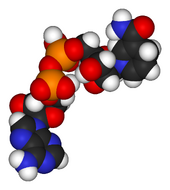Assessment |
Biopsychology |
Comparative |
Cognitive |
Developmental |
Language |
Individual differences |
Personality |
Philosophy |
Social |
Methods |
Statistics |
Clinical |
Educational |
Industrial |
Professional items |
World psychology |
Biological: Behavioural genetics · Evolutionary psychology · Neuroanatomy · Neurochemistry · Neuroendocrinology · Neuroscience · Psychoneuroimmunology · Physiological Psychology · Psychopharmacology (Index, Outline)

Coenzyme A
Coenzymes are small organic non-protein molecules that carry chemical groups between enzymes.
Terminology[]
The term coenzymes is commonly used loosely, and coenzymes can also be defined as organic, non-protein cofactors.[1] Coenzymes are also sometimes referred to as cosubstrates, but this usage is unusual.
Coenzymes are consumed in the reactions in which they are substrates, for example: the coenzyme NADH is converted to NAD+ by oxidoreductases. Coenzymes are however regenerated and their concentration maintained at a steady level in the cell.
A special subset of coenzymes are prosthetic groups. These have more in common with cofactors since they are tightly bound to enzymes and are not released as part of the reaction. Prosthetic groups include molybdopterin, lipoamide and biotin.
Coenzymes as metabolic intermediates[]

Space-filling model of the coenzyme nicotinamide adenine dinucleotide.
Metabolism involves a vast array of chemical reactions, but most fall under a few basic types of group transfer reactions.[2] This common chemistry allows cells to use a small set of metabolic intermediates to carry chemical groups between different reactions.[3] These group-transfer intermediates are called coenzymes. Each class of group-transfer reaction is carried out by a particular coenzyme, which is the substrate for a set of enzymes that produce it, and a set of enzymes that consume it. An example of this are the dehydrogenases that use nicotinamide adenine dinucleotide (NADH) as a cofactor. Here, hundreds of separate types of enzymes remove electrons from their substrates and reduce NADH and this reduced coenzyme is then a substrate for any of the reductases in the cell that need to reduce their substrates.[4]
Types[]
Many coenzymes are phosphorylated water-soluble vitamins. However, nonvitamins may also be coenzymes, such as ATP, the biochemical carrier of phosphate groups, or coenzyme A, the coenzyme that carries acyl groups.
[]
- Ascorbic acid (Vitamin C)
- Coenzyme A
- Coenzyme B12
- Riboflavin (B2) - FAD and FMN
- Thiamine pyrophosphate (B1)
[]
- Coenzyme Q. (Coenzyme Q is unusual as it carries electrons between enzymes by diffusing within cell membranes, as this coenzyme is not water soluble. )
- Molybdopterin
- NAD
- NADP
See also[]
References[]
- ↑ Nelson, David L.; Michael M. Cox (2005). Lehninger Principles of Biochemistry, 841, New York: W. H. Freeman and company.
- ↑ Mitchell P (1979). The Ninth Sir Hans Krebs Lecture. Compartmentation and communication in living systems. Ligand conduction: a general catalytic principle in chemical, osmotic and chemiosmotic reaction systems. Eur J Biochem 95 (1): 1-20.
- ↑ Wimmer M, Rose I. Mechanisms of enzyme-catalyzed group transfer reactions. Annu Rev Biochem 47: 1031-78.
- ↑ Pollak N, Dölle C, Ziegler M (2007). The power to reduce: pyridine nucleotides--small molecules with a multitude of functions. Biochem J 402 (2): 205-18.
External links[]
Proteins: enzymes | |
|---|---|
| Topics |
Active site - Allosteric regulation - Binding site - Catalytically perfect enzyme - Coenzyme - Cofactor - Cooperativity - EC number Enzyme catalysis - Enzyme inhibitor - Enzyme kinetics - Lineweaver-Burk plot - Michaelis-Menten kinetics - List of enzymes |
| Types |
EC1 Oxidoreductases/list - EC2 Transferases/list - EC3 Hydrolases/list - EC4 Lyases/list - EC5 Isomerases/list - EC6 Ligases/list |
| This page uses Creative Commons Licensed content from Wikipedia (view authors). |